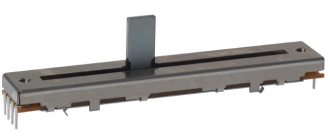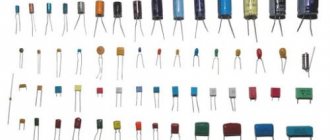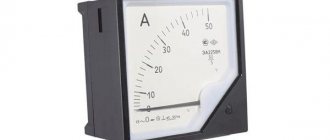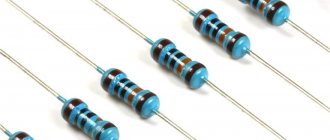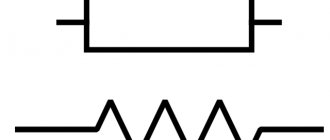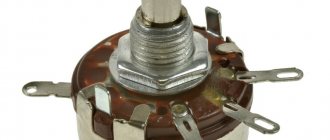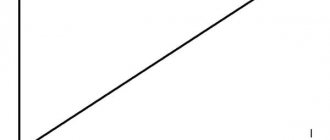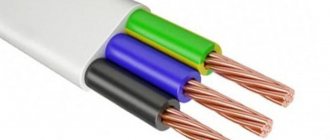Types of resistors
The cases of this type of product can have a cylindrical or rectangular shape. Based on the characteristics of behavior, the following types of these elements can be distinguished:
- Constant - have a constant (not changing) resistance. They are used if a circuit fragment requires maintaining a certain voltage or current value. To select such a device, you have to take measurements with a multimeter and calculate the required parameter values.
- Variable – with the ability to adjust resistance. Control can take the form of steps or be smooth. Can be used, for example, to regulate sound level.
- Adjustable - a variation of the previous type, which very rarely requires manual adjustment.
- Devices whose resistance is variable and depends on ambient temperature or lighting.
Important! Nonlinear components of almost all varieties are made of semiconductor materials.
What is it for?
A resistor is designed to provide resistance to the current flowing through the system. Used in various fields. The purpose of the device can be as follows:
- “Conversion” of current energy into voltage (or vice versa);
- Limiting the incoming force to the required level;
- Creating separators (for example, in measuring devices);
- Solving specialized problems (for example, reducing the impact of radio interference).
Important! The simplest way to use the device is to operate an LED. The element's own resistance is too low. Without a limiter - a resistor - the passing current will instantly damage the element.
Light-emitting diode
Resistor element parameters
Resistor resistance - formula for calculation
The key parameters of this group of parts include:
- component resistance;
- tolerance (degree of variability of the nominal resistance) – can take values up to 20%;
- TKS - change in resistance when heating or cooling air by 1 degree (it is advisable that the elements of one electrical circuit have an identical value of the indicator);
- power, showing how much thermal energy can be released into space while maintaining the correct functioning of the element.
Important! How much energy a component will dissipate is affected by its size. A trained eye is capable of visually determining the value based on the dimensions of the resistor. The correlation with magnitude is due to the fact that when current flows through an element with a large surface area, heat is released into space at a higher rate (if we are talking about air).
Miniature SMD components are marked with strips of different colors. The interpretation of the color code can be viewed online (for example, on the manufacturer’s website). Often it is given in the attached technical documentation.
Color coding of miniature parts
Series E12
In comparison with the previous one, it will no longer have six, but twelve options for ratings for electronic components from 1 to 8.2. The value of the nominal data increases proportionally.
According to their characteristics, the E12 series differ in the following data:
- the permissible error of inductors or resistors is no more than 10%;
- if the resistor has a color marking, then the strip indicating a possible deviation from the declared resistance should be gray or silver;
- Their scope of application covers the field of trimmers and variable resistors, and is also used for some household appliances.
Resistor calculation
To correctly select a component for a circuit, you will need to find the values of its key indicators. With different types of connections of several components, the parameters will take different values.
Serial connection
Resistor E24 resistance range
When using a series circuit, the resulting resistance value is equal to the sum of the individual values for each resistor. Using this rule, you can find out which component with which indicator should be purchased. For example, you need to get 220 Ohms in the circuit, there is a device for 130 Ohms. Therefore, you need to buy a second one for 220-130 = 90 Ohms. The current flowing in the circuit and the current on each resistor element in this case have the same value.
Parallel connection
Formula for total resistance:
R=R1*R2/(R1+R2).
From it you can find out the target resistance of the element that needs to be purchased. The electric current in the unbranched part of the network in this case is equal to the sum of the currents of the individual branches.
Important! Unlike the previous case, this scheme is recommended for use if the indicators for individual elements exceed the total required R.
Mixed compound
It includes combinations of structures of the two previously designated types. To calculate the indicators for individual resistors, the circuit will need to be simplified.
Decomposition of a mixed circuit into parts
Power
To select the right part, you need to know how to correctly determine the power of the resistor. This can be done based on the formulas:
P=U2/R=I2*R.
It must be taken into account that the use of a part with a parameter exceeding the recommended one is acceptable, but the opposite case is not.
Series E24
This type of marking has twice the number of denominations compared to the previous one.
Distinctive features of the E24 series are:
- Deviation from the value set by the manufacturer is allowed no more than 5%; a larger value is unacceptable due to overlap of the adjacent value
- the colored stripes for such nominal rows are golden in color;
- most common among radio amateurs, since the wire leads are easy to solder and use for assembling electrical circuits, and the percentage of error does not greatly affect the electrical parameters.
Types and designations of resistors
Basically, products with typical dissipation power values (0.05, 0.125, 0.25, 0.5, 1, 2 and 5 Watts) are produced for sale. Visual designations of products with different ratings on electrical circuits are regulated by GOST. Before assembly, you need to check that the parts used correspond to the ratings indicated on the diagram. Elements are also produced with other power indicators that differ from the standards. In practice, they are used infrequently, mainly for a specific task.
Specifications for the designed circuit, as a rule, contain instructions on what values of the main parameters the resistor should have. Sometimes even a specific model is indicated, as well as the permissible deviation from the fixed nominal value.
Designation of parts with different ratings
What is a series of denominations?
This concept establishes a certain pattern of alternating values for any radio components, including resistors. The existing standard was first approved back in 1948 and was designated by the Latin letter E, meaning EIA in the Electronic Industries Alliance. Following the letter E is a number indicating a specific line of values; it also shows the number of denominations available in this series. For example, E6 breaks down the nominal power, capacitance or resistance in the range from 0 to 10 into six units; if compared with E96, it will already have 96 of these units.
From a mathematical point of view, nominal values are a logarithmic function, so the step of change in nominal resistances can be determined by the formula:
where n is the serial number of a particular member, and N is the number of the series.
To select the desired model from the proposed data lines, the set value, for example, for E12 is 1... 1.2... 1.5... etc. and multiplied by a decimal factor - 10, 100, 1000, etc. until the desired value is reached. There are seven standard denominations in total, although the first of them is no longer produced today, but you can still find it in old devices. Next, we will consider the features of each of a number of part ratings.
Part heating depending on resistance
When choosing a suitable resistor, you must pay attention to the temperature range at which correct operation of the part is possible. It is always specified by the manufacturer. In order for the resistor not to fail, timely release of heat into the atmosphere is necessary. The element must not overheat. The colder the air (within the acceptable range), the longer the component has a chance to last. Do not allow excess heat to accumulate near the resistor.
When the temperature indicator reaches its maximum within the range, the process of burning out the upper marked layer begins at the resistance. In this case, it is necessary to take measures to reduce the temperature, otherwise the product’s filling, which is responsible for resistance, will burn out and it will become completely unsuitable for further use.
If a part with the required dimension for a specific circuit is not found, you can use the option with a superior value if it suits the device being assembled. Resistors whose power data does not reach the required ones can be used in such a situation only by combining them in series. In general, knowledge of the effects of parallel and series connected resistor elements will be useful in a situation where there is no part with ideally suitable parameters at hand.
Series E48
The number of options for resistance to electric current is still twice as large as E24; starting from it, the values are separated not only by tenths, but also by hundredths. A distinctive feature of this and subsequent series is their high accuracy, namely, E48 can deviate from the declared data by only 2%.
To indicate the E48 series of colored stripes, red is applied; in the operation of household appliances, such a deviation is completely invisible, since ordinary voltage fluctuations in the electrical circuit have a much more significant effect. Therefore, their use in modeling is highly specific and belongs to precise elements.
Resistor power
The power dissipation of a resistor by appearance is most clearly determined by Soviet cylindrical products; they differ noticeably in size. Their marking has the following standard:
- the first letters are the type of element (for example, MLT - varnished metal film);
- then a hyphen, the first digit after it is the power value;
- then the resistance was indicated (in the case of kOhm, the whole part was separated from the fractional letter K: 1 K6 - 1.6);
- percentage deviation - for example, 6%.
For imported products, the markings have the form of colored stripes, where each color represents a specific number. There are variations with 3, 4, 5 stripes.
Without knowing the power characteristics, it will not be possible to select a suitable element for installing an electrical circuit. Using a resistor that is irrelevant for this indicator will cause it to overheat and quickly become inoperative.
Row E6
Here, to indicate denominations, there are six possible values: 1; 1.5; 2.2; 3.3; 4.7; 6.8. When indicating the nominal capacitances, resistances and other characteristics of radio components, E6 has the following differences:
- the error tolerance is no more than 20%, which gives a considerable deviation, which must be taken into account when operating precision instruments;
- when using color markings for ceramic or carbon resistors, the parts will have a black stripe, characterizing their possible error;
Determination of permissible deviation by color marking
- They are most widespread in power equipment, where the main role of the resistor is to dampen the current load, and the existing error will not have a significant effect.
